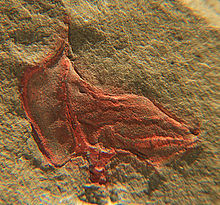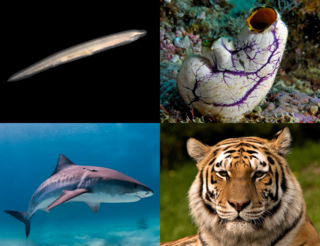
A chordate is a deuterostomic animal belonging to the phylum Chordata. All chordates possess, at some point during their larval or adult stages, five distinctive physical characteristics (synapomorphies) that distinguish them from other taxa. These five synapomorphies are a notochord, a hollow dorsal nerve cord, an endostyle or thyroid, pharyngeal slits, and a post-anal tail. The name "chordate" comes from the first of these synapomorphies, the notochord, which plays a significant role in chordate body plan structuring and movements. Chordates are also bilaterally symmetric, have a coelom, possess a closed circulatory system, and exhibit metameric segmentation.

A skeleton is the structural frame that supports the body of most animals. There are several types of skeletons, including the exoskeleton, which is a rigid outer shell that holds up an organism's shape; the endoskeleton, a rigid internal frame to which the organs and soft tissues attach; and the hydroskeleton, a flexible internal structure supported by the hydrostatic pressure of body fluids.
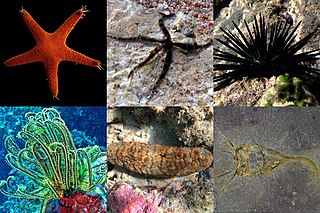
An echinoderm is any member of the phylum Echinodermata. The adults are recognisable by their radial symmetry, or pentamerous symmetry, and include starfish, brittle stars, sea urchins, sand dollars, and sea cucumbers, as well as the sea lilies or "stone lilies". Adult echinoderms are found on the sea bed at every ocean depth, from the intertidal zone to the abyssal zone. The phylum contains about 7,000 living species, making it the second-largest grouping of deuterostomes, after the chordates. Echinoderms are the largest entirely marine phylum. The first definitive echinoderms appeared near the start of the Cambrian.

Crinoids are marine invertebrates that make up the class Crinoidea. Crinoids that are attached to the sea bottom by a stalk in their juvenile form are commonly called sea lilies, while the unstalked forms, called feather stars or comatulids, are members of the largest crinoid order, Comatulida. Crinoids are echinoderms in the phylum Echinodermata, which also includes the starfish, brittle stars, sea urchins and sea cucumbers. They live in both shallow water and in depths as great as 9,000 meters (30,000 ft).

Graptolites are a group of colonial animals, members of the subclass Graptolithina within the class Pterobranchia. These filter-feeding organisms are known chiefly from fossils found from the Middle Cambrian through the Lower Carboniferous (Mississippian). A possible early graptolite, Chaunograptus, is known from the Middle Cambrian. Recent analyses have favored the idea that the living pterobranch Rhabdopleura represents an extant graptolite which diverged from the rest of the group in the Cambrian. Fossil graptolites and Rhabdopleura share a colony structure of interconnected zooids housed in organic tubes (theca) which have a basic structure of stacked half-rings (fuselli). Most extinct graptolites belong to two major orders: the bush-like sessile Dendroidea and the planktonic, free-floating Graptoloidea. These orders most likely evolved from encrusting pterobranchs similar to Rhabdopleura. Due to their widespread abundance, planktonic lifestyle, and well-traced evolutionary trends, graptoloids in particular are useful index fossils for the Ordovician and Silurian periods.

Sea urchins are spiny, globular echinoderms in the class Echinoidea. About 950 species of sea urchin are distributed on the seabeds of every ocean and inhabit every depth zone from the intertidal seashore down to 5,000 meters. The spherical, hard shells (tests) of sea urchins are round and covered in spines. Most urchin spines range in length from 3 to 10 cm, with outliers such as the black sea urchin possessing spines as long as 30 cm (12 in). Sea urchins move slowly, crawling with tube feet, and also propel themselves with their spines. Although algae are the primary diet, sea urchins also eat slow-moving (sessile) animals. Predators that eat sea urchins include a wide variety of fish, starfish, crabs, marine mammals, and humans.
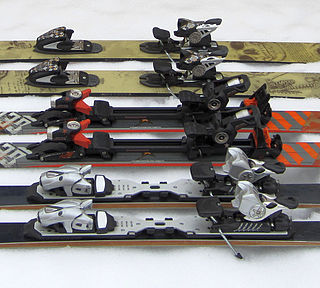
A ski binding is a device that connects a ski boot to the ski. Before the 1933 invention of ski lifts, skiers went uphill and down and cross-country on the same gear. As ski lifts became more prevalent, skis—and their bindings—became increasingly specialized, differentiated between alpine (downhill) and Nordic styles of skiing. Until the point of divergence in the mid-20th century, bindings held the toe of a flexible, leather boot against the ski and allowed the heel to rise off the ski, typically with a form of strap or cable around the heel.

Starfish or sea stars are star-shaped echinoderms belonging to the class Asteroidea. Common usage frequently finds these names being also applied to ophiuroids, which are correctly referred to as brittle stars or basket stars. Starfish are also known as asteroids due to being in the class Asteroidea. About 1,900 species of starfish live on the seabed in all the world's oceans, from warm, tropical zones to frigid, polar regions. They are found from the intertidal zone down to abyssal depths, at 6,000 m (20,000 ft) below the surface.

Sea cucumbers are echinoderms from the class Holothuroidea. They are marine animals with a leathery skin and an elongated body containing a single, branched gonad. They are found on the sea floor worldwide. The number of known holothurian species worldwide is about 1,786, with the greatest number being in the Asia-Pacific region. Many of these are gathered for human consumption and some species are cultivated in aquaculture systems. The harvested product is variously referred to as trepang, namako, bêche-de-mer, or balate. Sea cucumbers serve a useful role in the marine ecosystem as they help recycle nutrients, breaking down detritus and other organic matter, after which bacteria can continue the decomposition process.

A tunicate is a marine invertebrate animal, a member of the subphylum Tunicata. It is part of the Chordata, a phylum which includes all animals with dorsal nerve cords and notochords. The subphylum was at one time called Urochordata, and the term urochordates is still sometimes used for these animals. They are the only chordates that have lost their myomeric segmentation, with the possible exception of the 'seriation of the gill slits'. However, doliolids still display segmentation of the muscle bands.

Pikaia gracilens is an extinct, primitive chordate animal known from the Middle Cambrian Burgess Shale of British Columbia. Described in 1911 by Charles Doolittle Walcott as an annelid, and in 1979 by Harry B. Whittington and Simon Conway Morris as a chordate, it became "one of the most famous early chordate fossils," or "famously known as the earliest described Cambrian chordate". It is estimated to have lived during the latter period of the Cambrian explosion. Since its initial discovery, more than a hundred specimens have been recovered.

Kentrosaurus is a genus of stegosaurid dinosaur from the Late Jurassic in Lindi Region of Tanzania. The type species is K. aethiopicus, named and described by German palaeontologist Edwin Hennig in 1915. Often thought to be a "primitive" member of the Stegosauria, several recent cladistic analyses find it as more derived than many other stegosaurs, and a close relative of Stegosaurus from the North American Morrison Formation within the Stegosauridae.
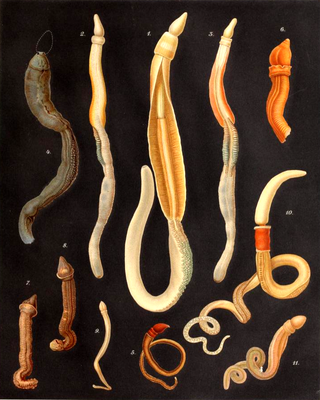
The acorn worms or Enteropneusta are a hemichordate class of invertebrates consisting of one order of the same name. The closest non-hemichordate relatives of the Enteropneusta are the echinoderms. There are 111 known species of acorn worm in the world, the main species for research being Saccoglossus kowalevskii. Two families—Harrimaniidae and Ptychoderidae—separated at least 370 million years ago.

The stylophorans are an extinct, possibly polyphyletic group allied to the Paleozoic Era echinoderms, comprising the prehistoric cornutes and mitrates. It is synonymous with the subphylum Calcichordata. Their unusual appearances have led to a variety of very different reconstructions of their anatomy, how they lived, and their relationships to other organisms.

Mitrates are an extinct group of stem group echinoderms, which may be closely related to the hemichordates. Along with the cornutes, they form one half of the Stylophora.
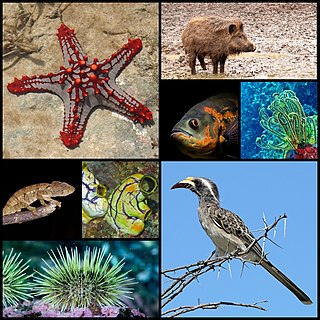
Deuterostomes are bilaterian animals of the superphylum Deuterostomia, typically characterized by their anus forming before the mouth during embryonic development. The three major clades of extant deuterostomes include chordates, echinoderms and hemichordates.
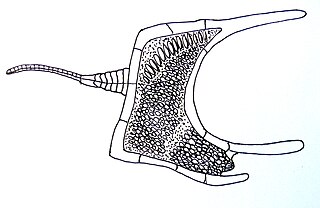
Homalozoa is an obsolete extinct subphylum of Paleozoic era echinoderms, prehistoric marine invertebrates. They are also referred to as carpoids.
The calcichordate hypothesis holds that each separate lineage of chordate evolved from its own lineage of mitrate, and thus the echinoderms and the chordates are sister groups, with the hemichordates as an out-group.
Fossils of many types of water-dwelling animals from the Devonian period are found in deposits in the U.S. state of Michigan. Among the more commonly occurring specimens are bryozoans, corals, crinoids, and brachiopods. Also found, but not so commonly, are armored fish called placoderms, snails, sharks, stromatolites, trilobites and blastoids.

Cincta is an extinct class of echinoderms that lived only in the Middle Cambrian epoch. Homostelea is a junior synonym. The classification of cinctans is controversial, but they are probably part of the echinoderm stem group.
